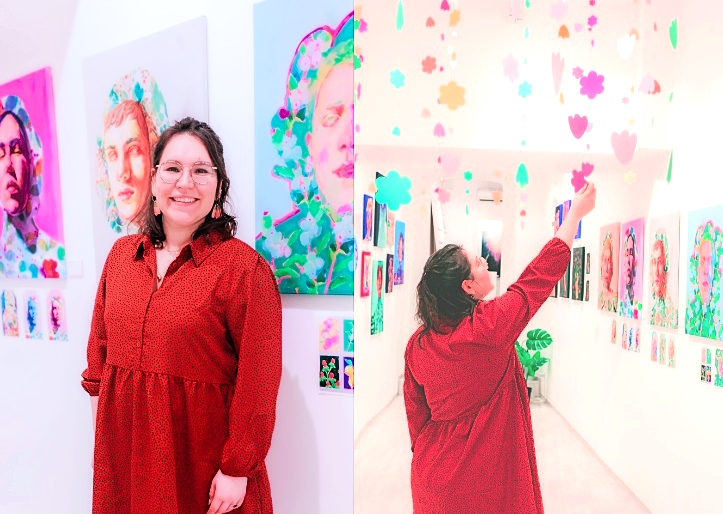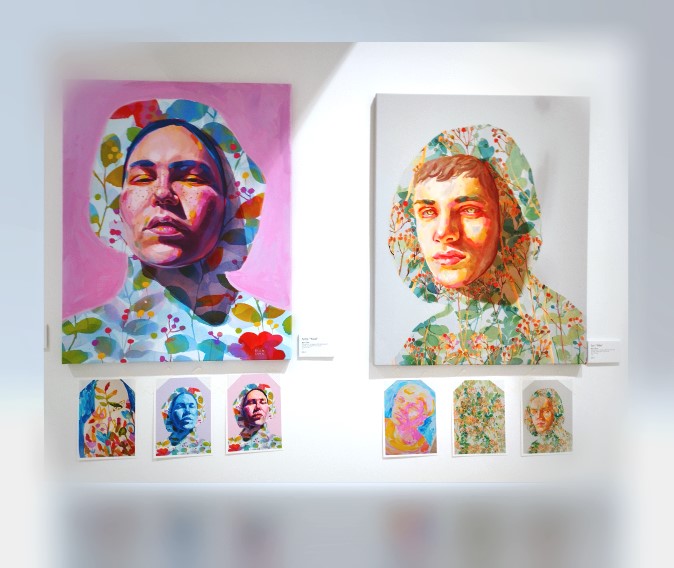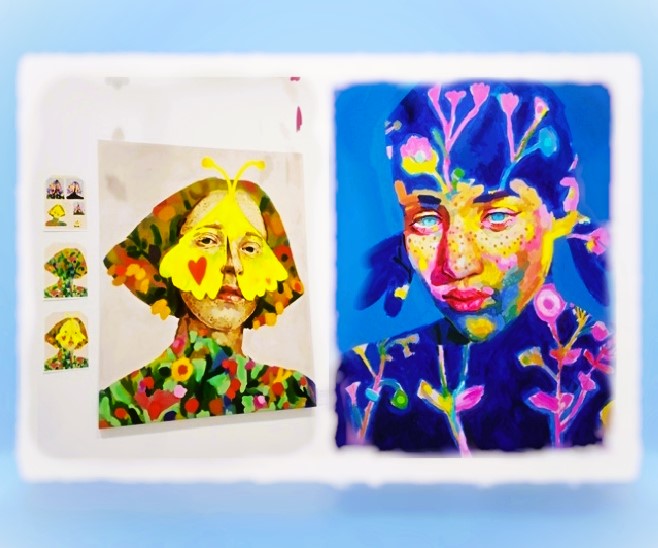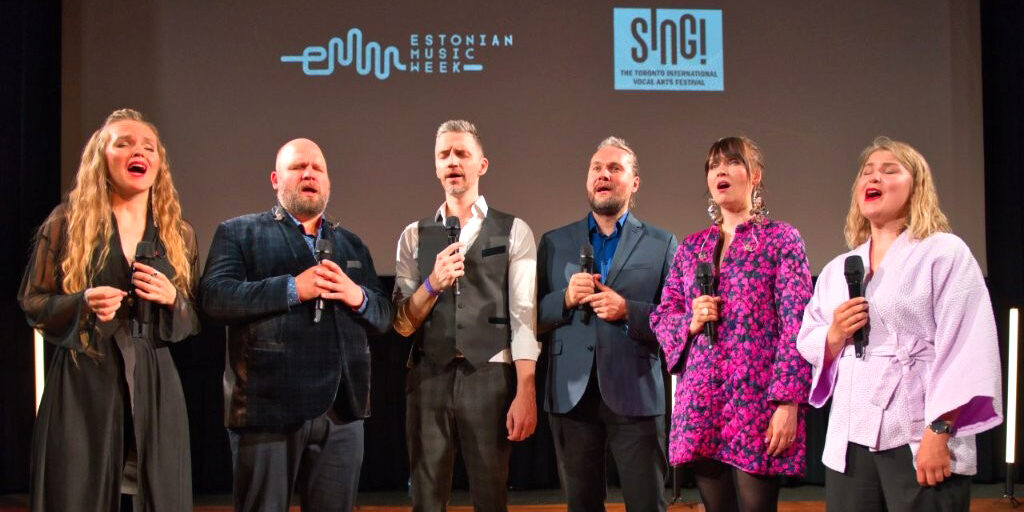Summer is coming, and people are actively planting flowers in parks and gardens throughout Estonia. Meanwhile, the Victoria Olt Gallery is currently hosting the exhibition, “Flora Aed” (“Flora’s Garden”), which features lively images of people, overlayed with delicate botanical compositions of fresh foliage, inflorescences, fungi, insects, and birds. The author of these vibrant paintings is the Netherlands-based artist known as Riso Chan, who introduces herself as follows: “My name is Àngela Maria Sierra. I’m a Spanish artist and art teacher. For the last ten years I have been living in the Netherlands, which I enjoy very much.”

Riso Chan's paintings inspired me from the moment I first saw them. These canvases present quite realistic images of people’s faces and torsos. However, an invisible dimension seems to shine through them. The paintings emit light – even those with dark backgrounds. The images breathe the spirit of vegetation, communicating the warm vibrations of blossoming groves and gardens. Many of the faces are freckled – a sign of the approaching warm season, which is emphasized by bright colour spots and floral patterns. The eyes of the people in the portraits radiate some special unearthly glow, as if they look from afar – somewhere into the distance, into this other dimension which is most often invisible. The faces magically mesmerize us, the audience, as if we see these people through the iridescent thickness of the sun’s rays.
Remarkably, the floral ornament is not at all perceived as a complementary decorative element, but rather a natural and integral part of the images, which only makes them more accurate. These subtle plant patterns on faces and torsos, together with bright spots of light, reflect precisely those facets of the human being that we are sometimes able to feel, but often do not know how to express. I decided to ask for an interview with this artist whose paintings remind us of a very important and, unfortunately, forgotten truth – we, all people, animals, birds, trees, flowers, insects, and mushrooms – are part of one ancient, beautiful garden, which, as some people believe, was once open to everyone.
Riso, why and how did you become an artist?
I come from a family of artists. My mom is a sculptress, my grandmother a painter and also a sculptress, and my father is a musician. This means that art is really appreciated and encouraged in my family. I liked being next to my mom when she was working with clay. She always invited my sister and I to join her and she would set up some materials for us. Same with painting, my mother always made sure we had materials to experiment with and to express ourselves. She always genuinely admired anything I painted and it really inspired me to keep trying.

Why did you choose the name Riso Chan for your self-representation as an artist? What does this name mean?
“… a new name gave me the freedom to reinvent myself, which is beneficial for my emotional wellbeing.”
(Riso Chan)
I knew from the beginning of my art career that I wanted to use a different name than my own. I felt that my own name compelled me to be who everyone else thought I was, and a new name gave me the freedom to reinvent myself, which is beneficial for my emotional wellbeing.
It also helps me separate my personal worth from my social media presence and follower count, focusing on my art rather than external validation.
The name Riso Chan doesn’t have a deep meaning. I chose it because I used to work with a Riso machine, a Japanese printing device. In the Japanese language, “chan” is an endearing suffix often used to express affection towards children or things that are considered cute. I found the machine cute and charming, so I called it Riso Chan. Even though it was initially the name for the machine, it eventually became my artistic name.
Do you have any special connection with Japan?
Yes, as a child, I believed I was Japanese. When I found out I wasn't, I would say that I wanted to be Japanese when asked what I wanted to be when I grew up. I imagine this is because most TV cartoons in Spain during the 90s came from Japan.
What do you call this art style?
I’m not sure what specific art style my work falls into, but I think “abstract realism” might be a fitting description.
Why did you decide to integrate botanical elements into your paintings?
The idea came to me through a lot of play and experimentation. At first, I mixed child-like drawings with portraits to talk about my inner child. But then I had the idea of using nature to express the pure side of ourselves, and it really stuck. Now when I paint a portrait without nature, I feel like something is missing.
Could you please elaborate, what you mean by “the pure side of ourselves?”
I believe we all have two sides: the personality we are born with and the part that is shaped by our experiences. Given that my upbringing was very challenging, I felt a strong need to explore and express who I was beyond my experiences. It is this part of human personality that I refer to as “the pure side of ourselves.” This exploration helps me connect with the untainted aspects of our identity.
Do you have a favourite plant/insect?
Right now, my daughter and I are into ladybugs, mainly because she gets very excited when we find one.
Who are your models and how do you find them?
They are a mix of myself, people I know, and people I don’t know. There are some internet sites where artists share their own photos for other artists to paint, which I really enjoy. I’m always looking for portraits under the sun, because the colours of the skin become very vibrant.

What artists, writers, poets, filmmakers inspire you?
I’m very inspired by contemporary painters whose work is focused on exploring colour, like Sainer and Keita Morimoto. I also like some colour key artists for animation like Angela Sung and Beatrice Blue. A few years ago, I attended a workshop by Agnes Cecile, a watercolour painter, which was crucial in helping me find my artistic voice by understanding her intuitive process. Growing up, I was influenced by the animations of Disney and Studio Ghibli, which started my love for saturated colours. I’m not a fan of poetry, but fantasy literature is a regular part of my reading.
How did your exhibition in the Victoria Olt Gallery come about?
They asked me to! I feel so lucky because they are an incredible team of driven women. They are exhibiting my work in one of the rooms, and Eliis Kuusk’s work in another room. They also have a beautiful permanent collection!
Have you had exhibitions in Estonia before?
Yes, although it was a collective exhibition. Last December this same gallery hosted a “collection starter” exhibition, in which they invited many artists to join. They included five of my works.
Do you often come to Estonia? What do you think about the country?
I came to Estonia for the first time in early May at the exhibition opening. I really liked the city; the Old Town is beautiful, and me and my family enjoyed walking around and discovering the city. We visited the Alexander Nevsky Cathedral and were fortunate to experience a live choir performance, which made the visit even more special.
What are your plans for the future? Are you going to have more exhibitions in Estonia?
Currently, I’m working on a couple of projects that involve teaching painting. I definitely hope to have another exhibition in Estonia in the future, as my first experience there was wonderful!
“…if creating brings you joy, keep doing it. The process can sometimes be frustrating, but the journey is rewarding…”
(Riso Chan)
Do you have a message for those reading this interview?
I hope you can visit the exhibition (which will be open until June 30th, 2024) at the Victoria Olt Gallery. Even if you don’t buy anything, the people there are welcoming, and we are proud to showcase the work we’ve put together. Also, if creating brings you joy, keep doing it. The process can sometimes be frustrating, but the journey is rewarding, regardless of the final outcome.
Jerry Mercury, Tallinn, May 2024



